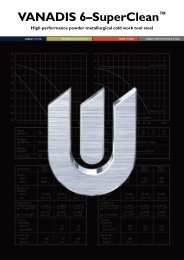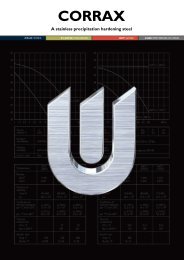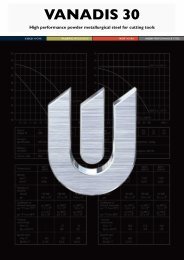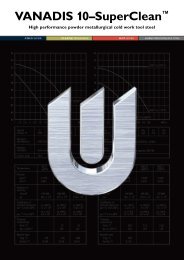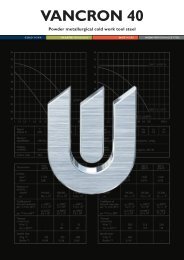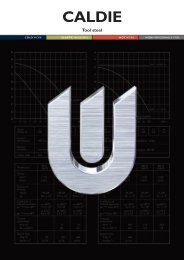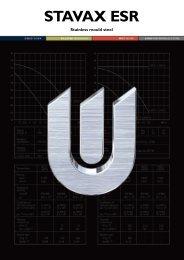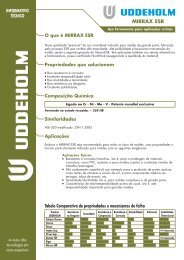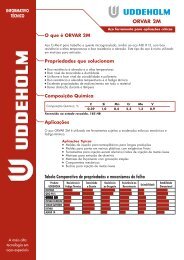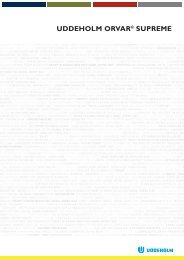THG 2000 eng-03 - Uddeholm
THG 2000 eng-03 - Uddeholm
THG 2000 eng-03 - Uddeholm
You also want an ePaper? Increase the reach of your titles
YUMPU automatically turns print PDFs into web optimized ePapers that Google loves.
<strong>THG</strong> <strong>2000</strong><br />
Tempering within the range 425–525°C (800–<br />
980°F) is not normally recommended, due to the<br />
fact that toughness properties are degraded in this<br />
temperature range.<br />
DIMENSIONAL CHANGES DURING HARDENING<br />
Test plate size 100 x 100 x 25 mm<br />
Width L<strong>eng</strong>th Thickness<br />
% % %<br />
Oil-hardened from<br />
1020°C (1868°F) min. –0,08 –0,06 0,00<br />
max. –0,15 –0,16 +0,30<br />
Air-hardened from<br />
1020°C (1868°F) min. –0,02 –0,05 –<br />
max. +0,<strong>03</strong> +0,02 +0,05<br />
Vacuum-hardened from<br />
1020°C (1868°F) min. +0,01 –0,02 +0,08<br />
max. +0,02 –0,04 +0,12<br />
DIMENSIONAL CHANGES DURING TEMPERING<br />
Dimensional changes %<br />
+0,12<br />
+0,08<br />
+0,04<br />
0<br />
–0,04<br />
–0,08<br />
–0,12<br />
100 200 300 400 500 600 700 °C<br />
210 390 570 750 930 1110 1290 °F<br />
Tempering temperature (1h + 1h)<br />
Note: The dimensional changes occurring during<br />
hardening and tempering are cumulative.<br />
CASE HARDENING<br />
Case hardening increases the surface hardness and<br />
wear resistance of the steel, increases its resistance<br />
to bending and twisting and improves the fatigue<br />
str<strong>eng</strong>th.<br />
<strong>THG</strong> <strong>2000</strong> can be case hardened as follows:<br />
Carburization temperature: 900°C (1650°F)<br />
Austenitizing temperature: 980°C (1795°F)<br />
Cooling: in air or oil<br />
Tempering: 250°C (480°F) twice, or 525°C<br />
(980°F) twice.<br />
Surface hardness: 58 ±3 HRC.<br />
NITRIDING<br />
Nitriding produces a hard surface layer which is very<br />
resistant to wear and erosion. However, the nitrided<br />
layer is brittle and can crack or spall if exposed to<br />
mechanical or thermal shock, with the risk increasing<br />
with layer thickness. Before nitriding, the part<br />
must be hardened and tempered at a temperature<br />
at least 50°C ( 90°F) above the nitriding temperature.<br />
Nitriding in ammonia at 510°C (950°F), or plasma<br />
nitriding at 480°C (896°F) in a 25% nitrogen—<br />
75% hydrogen mixture, can both produce a surface<br />
hardness of about 1100 HV 0,2 . In general, plasma<br />
nitriding is to be preferred, as it provides better<br />
control of the nitrogen potential. In particular, it<br />
avoids formation of the “white layer”, although gas<br />
nitriding can give perfectly acceptable results.<br />
<strong>THG</strong> <strong>2000</strong> can also be nitro-carburized in gas or salt<br />
baths, to produce a surface hardness of 900–<br />
1000 HV 0,2 .<br />
NITRIDING DEPTH<br />
Time Nitriding depth<br />
Process hours mm inch<br />
Gas nitriding 10 0,12 0,005<br />
at 510°C (950°F) 30 0,20 0,008<br />
Plasma nitriding 10 0,12 0,005<br />
at 480°C (896°F) 30 0,18 0,007<br />
Nitrocarburizing<br />
– in gas at<br />
580°C (1076°F) 2,5 0,11 0,004<br />
– in salt bath at<br />
580°C (1076°F) 1 0,06 0,002<br />
Nitriding to case depths more than 0,3 mm<br />
(0,012 inch) is not recommended for components<br />
intended for high-temperature applications.<br />
<strong>THG</strong> <strong>2000</strong> can also be nitrided in the soft-annealed<br />
condition, although its hardness and case depth will<br />
be somewhat reduced.<br />
Case hardening depth<br />
Carburizing time<br />
approx.<br />
mm inch<br />
2 hours ~0,35 ~0,014<br />
4 hours ~0,65 ~0,025<br />
16 hours ~1,30 ~0,051<br />
Use a mild carburization material.<br />
<strong>THG</strong> <strong>2000</strong> is a suitable material for various types of milling<br />
cutter bodies.<br />
4



